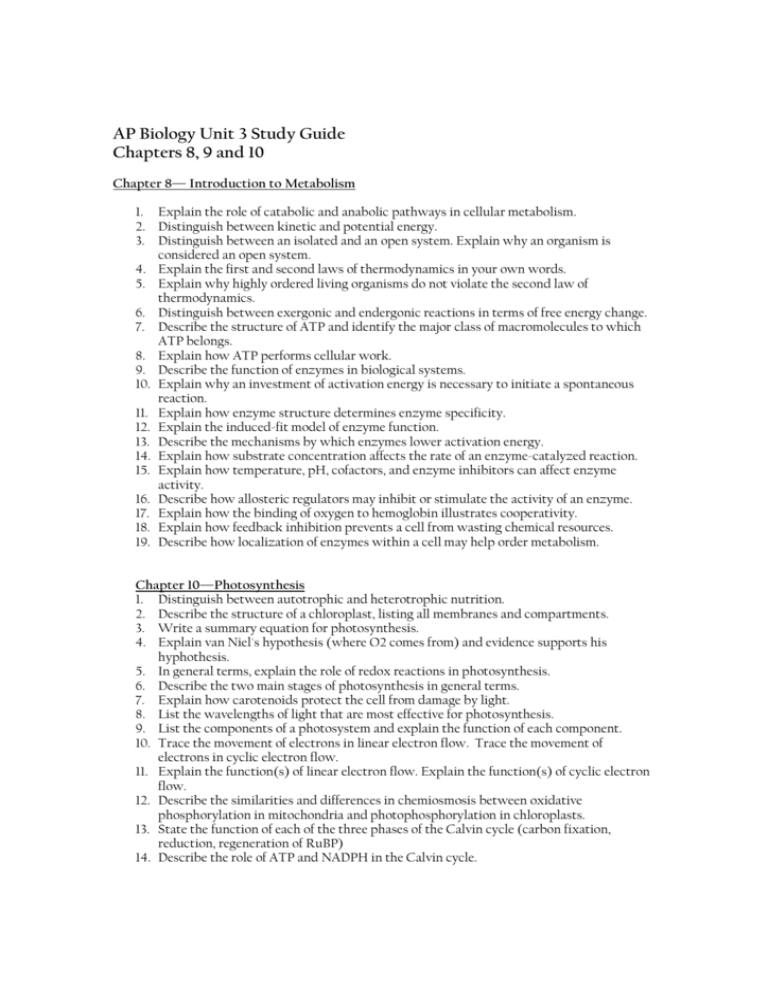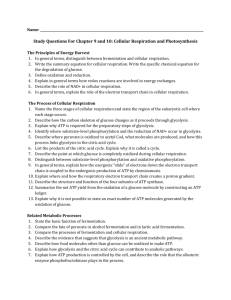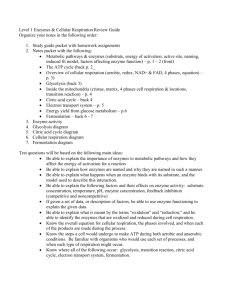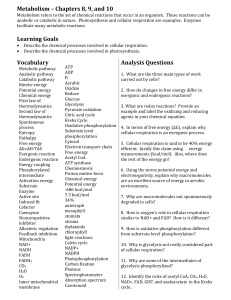AP Biology Unit 3 Study Guide Chapters 8, 9 and 10
advertisement

AP Biology Unit 3 Study Guide Chapters 8, 9 and 10 Chapter 8— Introduction to Metabolism 1. Explain the role of catabolic and anabolic pathways in cellular metabolism. 2. Distinguish between kinetic and potential energy. 3. Distinguish between an isolated and an open system. Explain why an organism is considered an open system. 4. Explain the first and second laws of thermodynamics in your own words. 5. Explain why highly ordered living organisms do not violate the second law of thermodynamics. 6. Distinguish between exergonic and endergonic reactions in terms of free energy change. 7. Describe the structure of ATP and identify the major class of macromolecules to which ATP belongs. 8. Explain how ATP performs cellular work. 9. Describe the function of enzymes in biological systems. 10. Explain why an investment of activation energy is necessary to initiate a spontaneous reaction. 11. Explain how enzyme structure determines enzyme specificity. 12. Explain the induced-fit model of enzyme function. 13. Describe the mechanisms by which enzymes lower activation energy. 14. Explain how substrate concentration affects the rate of an enzyme-catalyzed reaction. 15. Explain how temperature, pH, cofactors, and enzyme inhibitors can affect enzyme activity. 16. Describe how allosteric regulators may inhibit or stimulate the activity of an enzyme. 17. Explain how the binding of oxygen to hemoglobin illustrates cooperativity. 18. Explain how feedback inhibition prevents a cell from wasting chemical resources. 19. Describe how localization of enzymes within a cell may help order metabolism. Chapter 10—Photosynthesis 1. Distinguish between autotrophic and heterotrophic nutrition. 2. Describe the structure of a chloroplast, listing all membranes and compartments. 3. Write a summary equation for photosynthesis. 4. Explain van Niel's hypothesis (where O2 comes from) and evidence supports his hyphothesis. 5. In general terms, explain the role of redox reactions in photosynthesis. 6. Describe the two main stages of photosynthesis in general terms. 7. Explain how carotenoids protect the cell from damage by light. 8. List the wavelengths of light that are most effective for photosynthesis. 9. List the components of a photosystem and explain the function of each component. 10. Trace the movement of electrons in linear electron flow. Trace the movement of electrons in cyclic electron flow. 11. Explain the function(s) of linear electron flow. Explain the function(s) of cyclic electron flow. 12. Describe the similarities and differences in chemiosmosis between oxidative phosphorylation in mitochondria and photophosphorylation in chloroplasts. 13. State the function of each of the three phases of the Calvin cycle (carbon fixation, reduction, regeneration of RuBP) 14. Describe the role of ATP and NADPH in the Calvin cycle. 15. Describe what happens to rubisco when O2 concentration is much higher than CO2 concentration. 16. Describe the major consequences of photorespiration. Explain why it is thought to be an evolutionary relict. 17. Describe two important photosynthetic adaptations that minimize photorespiration. 18. Discuss the role of photosynthesis at an ecological level. Chapter 9—Cellular Respiration 1. In general terms, distinguish between fermentation and cellular respiration. 2. Write the summary equation for cellular respiration. 3. Define oxidation and reduction. 4. Explain in general terms how redox reactions are involved in energy exchanges. 5. Describe the role of NAD+ in cellular respiration. 6. In general terms, explain the role of the electron transport chain in cellular respiration. 7. Name the three stages of cellular respiration and state the region of the eukaryotic cell where each stage occurs. 8. Describe how the carbon skeleton of glucose changes as it proceeds through glycolysis. 9. Explain why ATP is required for the preparatory steps of glycolysis. 10. Identify where substrate-level phosphorylation and the reduction of NAD+ occur in glycolysis. 11. Describe where pyruvate is oxidized to acetyl CoA, what molecules are produced, and how this process links glycolysis to the citric acid cycle. 12. List the products of the citric acid cycle. Explain why it is called a cycle. 13. Describe the point at which glucose is completely oxidized during cellular respiration. 14. Distinguish between substrate level phosphorylation and oxidative phosphorylation. 15. In general terms, explain how the exergonic “slide” of electrons down the electron transport chain is coupled to the endergonic production of ATP by chemiosmosis. 16. Explain where and how the respiratory electron transport chain creates a proton gradient. Explain why this gradient is described as a proton motive force. 17. Summarize the net ATP yield from the oxidation of a glucose molecule. 18. Explain why it is not possible to state an exact number of ATP molecules generated by the oxidation of a molecule of glucose. 19. Compare the fate of pyruvate in alcohol fermentation and lactic acid fermentation. 20. Compare the processes of fermentation and cellular respiration. 21. Distinguish between obligate and facultative anaerobes. 22. Describe the evidence that suggests that glycolysis is an ancient metabolic pathway. 23. Describe how food molecules other than glucose can be oxidized to make ATP. 24. Explain how glycolysis and the citric acid cycle can contribute to anabolic pathways. 25. Explain how ATP production is controlled by the cell. Describe the role that the allosteric enzyme phosphofructokinase plays in this feedback control.









